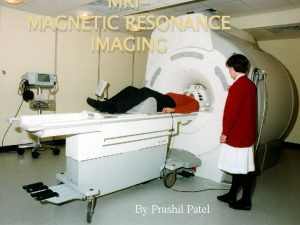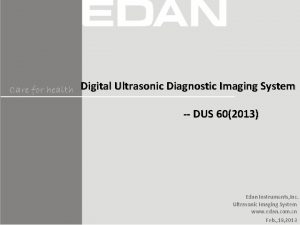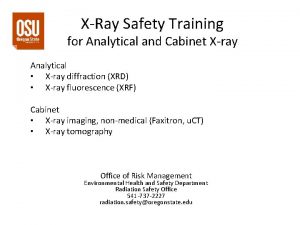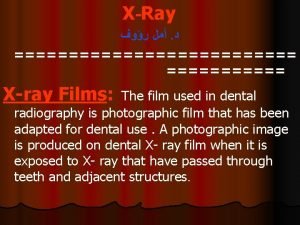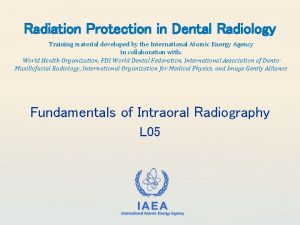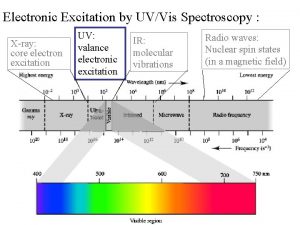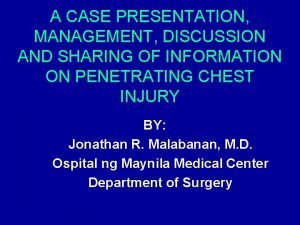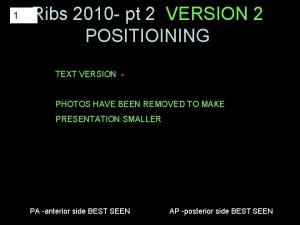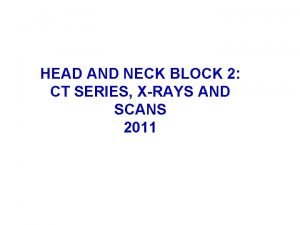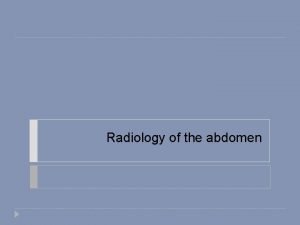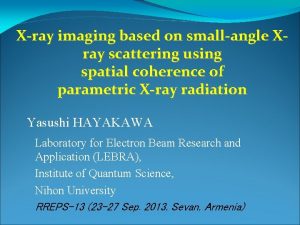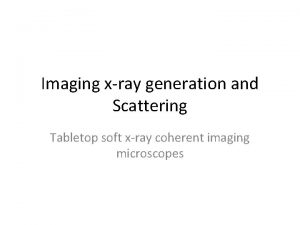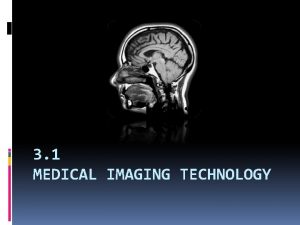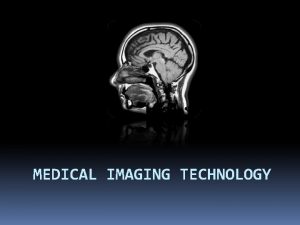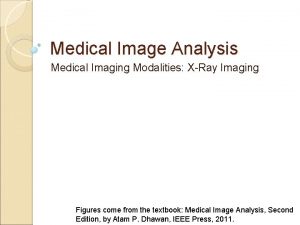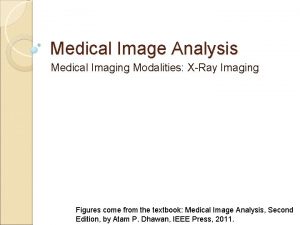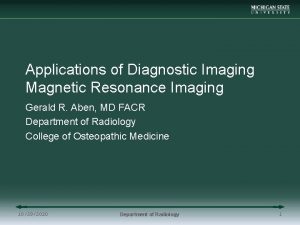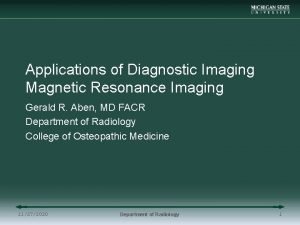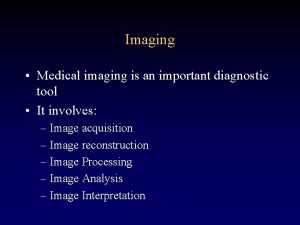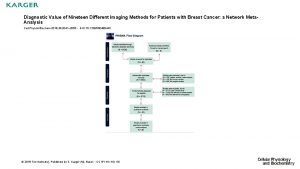DIAGNOSTIC XRAY IMAGING SAFETY TRAINING 2016 DIFFERENT IMAGING




















































- Slides: 52

DIAGNOSTIC X-RAY IMAGING SAFETY TRAINING 2016

DIFFERENT IMAGING MODALITIES This training presentation covers the following imaging modalities involving X-rays: • Radiography • Fluoroscopy (under-table and C-arm) • Computed Tomography (CT) • Intraoral Dental

X-RAY CHARACTERISTICS AND PRODUCTION

X-RAYS • X-rays are a type of ionizing electromagnetic radiation. • X-rays are a valuable tool, but there associated health risks. − These risks can be minimized by adhering to certain principles and practices as explained in this presentation. • X-rays are capable of traveling great distances and penetrating through lowdensity materials such as wood and plastic. • However, they can be blocked or attenuated by shielding made from highdensity materials such as lead and concrete.

X-RAY SHIELDING While all materials absorb X-rays, dense materials such as lead, steel and concrete are the most effective. Hence, they are the preferred shielding materials.

X-RAY PRODUCTION (1) • • • X-ray are generated in the X-ray tube of the device. Electrons, that have been accelerated using a high voltage source, are abruptly decelerated by striking a metal target (e. g. , copper, molybdenum, and tungsten). Some of the energy of the electrons that impinge upon the target are converted into X-rays.

X-RAY PRODUCTION (2) • X-ray production is proportional to operating potential (k. Vp) and current (m. A) • When the X-ray unit is not operating or it is powered down, the high voltage is not applied and X-rays are not produced. • Therefore, there is no danger present when the machine is not operating or it is powered down.

BIOLOGICAL EFFECTS, DOSE LIMITS, AND RADIATION SAFETY PRINCIPLES

DOSE • When radiation interacts with living material such as our bodies, they may deposit enough energy to cause biological damage. Biological damage can occur as a result of chemical bonds being broken, DNA damage, and cells being damaged or killed. • Radiation induced health effects are dependent on radiation dose. − The ‘rem’ is the common unit of dose in the U. S. o 1 rem = 1000 millirem (mrem) − The ‘sievert’ is the common international unit of dose. o 1 sievert = 100 rem

HEALTH EFFECTS OF RADIATION EXPOSURE • Health Effects from exposure to radiation range from no effect at all to death, including diseases such as cancer. • The health effects can be divided into two categories: 1. Early Effects 2. Delayed Effects

EARLY EFFECTS (1) • Occur shortly after exposures resulting in large doses (>100 rem), delivered within a short time period (acute exposure) • Acute exposures cause extensive biological damage to cells so that large numbers of cells are killed. • The severity of the health effects is proportional to the dose. • Possible health effects include: vomiting, diarrhea, skin burns, cataracts, hair loss, fever, lethargy, loss of appetite, changes in blood count, and death.

EARLY EFFECTS (2) • An estimated dose of around 325 rem for young healthy adults without medical intervention will result in death to 50% of the group within 60 days. • For a dose of less than about 800 rem, an exposed person is likely to survive with appropriate hospital care. • Under normal operation, the occurrence of early effects is highly unlikely.

DELAYED EFFECTS • Occur years after acute and chronic (low doses over a long time period) exposures. • Possible health effects include: leukemia, cancer, life span shortening, cataracts, and genetic defects.

DELAYED EFFECTS - GENETIC EFFECTS • Radiation studies involving fruit flies and mice suggest the possibility of heritable genetic effects in humans if there is radiation damage to the cells of the sperm or eggs. • These effects may show up as genetic defects in the children of exposed individuals and succeeding generations. • Scientists have studied populations of individuals exposed to radiation (e. g. , atomic bomb survivors and radiation workers) to identify the presence of heritable genetic effects. • To date, no heritable genetic effects from radiation have ever been observed in any human population exposed to doses ranging from natural background to that received by atomic bomb survivors.

DELAYED EFFECTS – STOCHASTIC • Leukemia, cancer, and genetic effects are considered stochastic effects; the probability of occurrence is dependent of dose. − As dose increases, the probability of occurrence increases. • Conservative studies estimate a 0. 04% increase of developing an adverse health effect per rem received. • For additional information, refer to Regulatory Guide 8. 29

GOVERNMENT DOSE LIMITS • In an effort to reduce the risk of potential health effects caused by radiation, the Indiana State Department of Health (ISDH) has set dose limits for those working with radiation producing devices. • These limits are put in place to create an upper limit of how much radiation a worker is allowed to be exposed to within a certain time period. • Individuals who stay below the dose limits: − Will not develop any early effects. − Will maintain a very small risk of developing delayed effects. 16

DOSE LIMIT VALUES The ISDH has permitted Purdue University to use Nuclear Regulatory Commission (NRC) dose limits. NRC Dose Limits (10 CFR 20. 1201) Section of Body Limit (rem) Whole Body (Head, torso and organs) 5 Lens of the Eye 15 Extremities (Hands, forearms, feet and ankles) 50 17

RADIATION & PREGNANCY (1) • Epidemiological studies of the A-bomb survivors, pregnant women who received pelvic X-rays, and animal studies indicate that embryos and fetuses are extremely radiosensitive. • The principle effects of radiation on the developing embryo and fetus, are embryonic, fetal, or neonatal death; congenital malformations; growth retardation; and functional impairment, such as mental retardation; and cancer. • The effects depend on the stage of gestation, the dose, and the dose rate. • These occurrences are extremely unlikely at Purdue because the doses possible from normal operation are very low.

RADIATION & PREGNANCY (2) • Pregnant individuals should take all precautions possible to keep exposures to the embryo or fetus as low as possible. • Extra precautions are taken by Purdue University for a Declared pregnant woman. • Declared pregnant woman means a woman who has voluntarily informed Purdue, in writing, of her pregnancy and the estimated date of conception. • If a declaration is made, it must be given to the Radiation Safety Officer (RSO) in writing.

RADIATION & PREGNANCY (3) • Once in effect, the pregnant worker’s exposure limit will be reduced to 10% of the occupational dose limit. • In addition, that worker will be given a fetal dosimeter to monitor the dose received by the embryo or fetus. • The declaration remains in effect until the declared pregnant woman withdraws the declaration in writing or is no longer pregnant. • For additional information, refer to Regulatory Guide 8. 13 20

ALARA • • The risk of developing delayed effects can be decreased by decreasing dose. Scientists accept the linear no-threshold theory which states that even low-doses carry some risk of developing delayed effects. The goal is not only to remain below the dose limits, but to keep it even lower by trying to keep doses As Low As Reasonably Achievable (ALARA). ALARA is not just a good idea, it is REQUIRED by law (410 IAC 5 Rule 4).

ALARA PRINCIPLES • There are several practices that will help you to keep your dose As Low As Reasonably Achievable (ALARA). − Time − Distance − Shielding

ALARA PRACTICES – TIME • Decreasing the time spent in a radiation area results in a lower accumulated dose. • Plan all work efficiently. • Follow the procedures or optimization techniques to avoid having to retake an X-ray. • Remember, X-rays units do not produce radiation unless they are in operation.

ALARA PRACTICES – DISTANCE • The greater the distance between you and the X-ray unit, the lower the dose. • Your goal is to never allow the distance between you and the unit to become zero. • Unless it’s necessary, avoid the need to hold the patient during an imaging procedures. – If you have to hold the patient during imaging, you must wear leaded aprons, gloves and thyroid collars.

ALARA PRACTICES – SHIELDING • Always use shielding. The greater the shielding, the lower the dose. • Lead and concrete works well to attenuate X-rays. • Available shielding includes: – Lead lined doors – Shielded X-ray control room – Portable X-ray barriers – Shielded glasses – Leaded aprons, thyroid collars, gloves and gonadal shields. • REM and your department will ensure sufficient shielding is available

DOSIMETRY (1) • Dosimetry – Device worn by radiation users to measure their accumulated dose. It is used to ensure that you do not exceed the governmentestablished dose limits. There are two types: 1. Ring – measures dose to the hands, worn on the hand receiving the highest dose with name facing the palm side 2. Whole-body – measures dose to the torso and head, worn on the part of the torso that will receive the highest dose. If wearing a lead vest, attach the dosimeter outside of the lead vest.

DOSIMETRY (2) • • If issued dosimetry, you MUST wear it every time you are operating X-ray equipment Dosimetry must be returned at the end of the wear period (monthly or bimonthly), to be analyzed. − Dose measurement may be lost if dosimeter is returned late − Lost dosimetry may result in a monetary fine

X-RAY DEVICE SAFETY FEATURES, AND EXPOSURE PATHWAYS

SAFETY FEATURES – HOUSING X-ray Tube Housing – When operating, X-rays are emitted in all directions. To protect operators and bystanders, the X-ray tube is enclosed in a shielded vessel that greatly reduces the dose.

SAFETY FEATURES - COLLIMATOR Beam Collimator – When operating, X-rays are emitted in all directions. To avoid exposing more of the body than necessary to X-rays, the collimator restricts the size of the exposed area to the tissue of interest. • The X-rays that are allowed to exit the collimator is called the primary beam

SAFETY FEATURES – BEAM STOP Beam Stop – The beam stop blocks many of the Xrays transmitted through the patient. This helps reduce the dose to occupants in adjacent rooms. The unit should never be operated without the beam stop. • For radiography units, the beam stop is usually the table bucky or bucky stand. • For Computed Tomography (CT) units, the detectors attached to the gantry operates as the beam stop. • For fluoroscopy units, the image intensifier operates as the beam stop. • For intraoral dental units, the beam stop is the patient and film. 31

SAFETY FEATURES – WARNING SIGNALS Visual and Audible Warning Signals – Signals are activated when the device is emitting X-rays. • The warning lights are usually located on the device or control panel 32

SAFETY FEATURES – DEAD MAN SWITCH Dead Man Switch – X-rays will only be generated when the operator actively presses the switch (i. e. button or foot pedal). When the operator ceases pressing the switch, X-rays are not generated.

SAFETY FEATURES – SHIELDING Shielded Room and Control Station – Xray facilities have shielded walls to reduce the dose to individuals in adjacent rooms and to the staff involved in the imaging procedure. • Radiological and Environmental Management (REM) performs a shielding analysis to ensure sufficient shielding is present

EXPOSURE PATHWAY With X-ray devices, an individual may get a dose from the following: • Primary/useful beam • Leakage radiation • Scatter radiation

EXPOSURE PATHWAY – PRIMARY BEAM Primary Beam – The useful beam of X-rays emitted from the X-ray tube. • Capable of acute radiation doses • Individuals working with or around X-ray devices should be familiar with the primary beam path

EXPOSURE PATHWAY – LEAKAGE Leakage Radiation – Despite the shielded X-ray tube housing, Xrays will escape. • Capable of causing chronic radiation doses • Manufacturer ensures that the dose rate from leakage radiation meets state regulations.

EXPOSURE PATHWAY – SCATTER Scatter Radiation – As X-rays from the primary beam interacts with the patient or couch, many of these will scatter in multiple directions, irradiating nearby individuals. • Capable of causing chronic radiation doses

MANDATORY SAFE PRACTICES AND STATE REGULATIONS

MANDATORY SAFE PRACTICES (1) • NEVER attempt to remove or bypass any system component (e. g. safety features). − These are meant to protect you and others from harmful radiation doses • DO NOT operate the unit in any manner other than specified in the procedures • DO NOT modify the X-ray device in any manner without approval of the radiation safety officer.

MANDATORY SAFE PRACTICES (2) • ALWAYS follow the ALARA principles discussed earlier − When producing X-rays, don’t stand closer to the device than necessary − When producing X-rays, reduce the amount of time spent around the system • DO NOT operate the X-ray system unless all system components and features are in good repair • NEVER place any part of your body in the primary beam

STATE REGULATIONS (1) • • • No person other than the medical doctor, veterinarian or state licensed radiation technician is allowed to operate a radiation producing device on humans. Individuals who will be operating the X-ray equipment shall be adequately instructed in properating procedures for such equipment. Written safety procedures and rules shall be available to each individual operating x-ray equipment, including any restrictions of operating technique required for the safe operation of the particular x-ray system. In the vicinity of each x-ray control panel, a technique guide shall be provided for routine examinations performed utilizing that system. Standard/Normal Operating Procedures: Step-by-step instructions necessary to accomplish the imaging.

STATE REGULATIONS (2) • Except for patients who cannot be moved out of the room, only the staff and ancillary personnel required for the medical procedure or training shall be in the room during the radiographic exposure. IN ADDITION to the patient being examined, others will be protected in the following manner: − All individuals shall be positioned such that no part of the body will be struck by the useful beam unless protected by 0. 5 mm lead equivalent. − Staff and ancillary personnel shall be protected from direct scattered radiation by protective aprons or whole body protective barriers of not less than 0. 25 mm lead equivalent. − Patients who cannot be removed from the room shall be protected from direct scattered radiation by whole body protective barriers of 0. 25 mm lead equivalent or shall be positioned so that portion of the body nearest to the tube head is at least 2 meters from both the tube head and the nearest edge of the image receptor.

STATE REGULATIONS (3) • • • Humans shall not be exposed to the useful beam, except for healing arts purposes and such exposure has been authorized by a practitioner of the healing arts. Deliberate exposure for training, demonstration, or other nonhealing arts purposes is prohibited. The following apply when a patient or film must be provided with auxiliary support during a radiation exposure: • Mechanical holding devices shall be used when the technique permits. • The human holder shall be protected as required in the previous slide. • No individual shall be used routinely to hold film or patients. • In those cases where the patient must hold the film, except during intraoral examinations, any portion of the body other than the area of clinical interest struck by the useful beam shall be protected by not less than 0. 5 mm lead equivalent material. Gonadal shielding of not less than 0. 25 mm lead equivalent shall be used for patients who have not passed the reproductive age during radiographic procedures in which the gonads are in the useful beam, except for cases in which this would interfere with the diagnostic procedure.

RADIOLOGICAL AND ENVIRONMENTAL MANAGEMENT (REM)

UNIVERSITY ORGANIZATION • • • The radiation safety program is empowered by Purdue University Executive Memorandum No. B-14 Purdue University’s radiation policies can be found in the Purdue Radiation Safety Manual The radiation safety program is managed by the: − Radiation Safety Committee (RSC) o Ensures the safety of the University and community in the utilization of all radioactive materials and radiation producing devices at the University or by University faculty, staff or students. − Department of Radiological and Environmental Management (REM) o Carries out the directives of the RSC. 46

ACCESS REQUIREMENTS The following requirements must be met before you are authorized to operate or work around X-ray devices: • Permission from the supervisor responsible for the X-ray device • Completion of REM’s X-ray safety training (this training presentation) • Submit completed A-4 form to REM • REM will only issue dosimetry to individuals who submit the A-4 form. • Specific training from the supervisor for the operation of the X-ray device. • Any additional requirements deemed necessary by the supervisor.

ENFORCEMENT Failure to comply with the rules, regulations safe practices established by Indiana State Department of Health (ISDH) or Purdue University can result : • Re-training • Loss of work privileges with or around X-ray producing devices • Obtaining an injunction or court order to prevent a violation • Civil penalties • Criminal penalties − For willful violation of, attempted violation of or conspiracy to violate any regulation 48

REM RESPONSIBILITIES REM is responsible for: • Performing X-ray machine inspections when new diagnostic X-ray devices are acquired, when diagnostic X-ray devices are moved, and on a routine basis afterwards. • Providing dosimetry to monitor radiation dose of users • Providing X-ray safety training for X-ray users. • REM is also responsible for complying with regulations set forth by the Indiana State , for the safe use of radiation producing devices such as X-ray units. − This is accomplished by providing training, calibration services, personnel dosimetry to monitor radiation exposure and consulting support for any safety issues identified by Purdue University employees and students. 49

CONTACT REM IF… • You know or suspect there has been an overexposure to an individual • The X-ray unit is to be modified • Personnel working on the project has been changed (added/dropped) • A new (or used) diagnostic X-ray unit has been acquired • The diagnostic X-ray unit will be operated in a different location 50

RADIATION SAFETY GROUP • James Schweitzer, Ph. D. Radiation Safety Officer (RSO) 49 -42350 jfschweitzer@purdue. edu • Matthew Tang Health Physicist 49 -42721 mmtang@purdue. edu • Kyle Smith Health Physicist 49 -41478 smith 514@purdue. edu • Jerry J. Gibbs Waste Handling & Meter Calibration 49 -40207 jjgibbs@purdue. edu 51

END OF TRAINING MODULE • • • This concludes the Power. Point portion of the training. Complete the test indicated below. You must have 75% of correct responses to pass. • Your results will be emailed to you, and will constitute as your certification of your successful completion of the online portion of your training, if you have passed. Submit a completed Form A-4 (make sure that both you AND your Principal Investigator have signed the form), and send through campus mail to: Sharon Rudolph/REM/HAMP Click here to begin the test.
 Frc control system
Frc control system Diagnostic imaging
Diagnostic imaging Digital ultrasonic diagnostic imaging system
Digital ultrasonic diagnostic imaging system Rah diagnostic imaging
Rah diagnostic imaging Ppmcs
Ppmcs Midwifery uwe
Midwifery uwe Xray training
Xray training Qbs safety care
Qbs safety care 2016 national patient safety goals
2016 national patient safety goals Ent
Ent The tube side of the dental film packet
The tube side of the dental film packet Kub xray
Kub xray Xray xml editor
Xray xml editor Sza xray
Sza xray Jfk jr plane crash photos
Jfk jr plane crash photos Mary beth sanders
Mary beth sanders Osteoid definition
Osteoid definition Rib anatomy anterior
Rib anatomy anterior Rhese method orbits x ray
Rhese method orbits x ray Smv sinuses
Smv sinuses Xray technique chart
Xray technique chart Bitewing periapical
Bitewing periapical Grid controlled x ray tube
Grid controlled x ray tube Lara xray
Lara xray Double exposure xray
Double exposure xray Double bond extending conjugation
Double bond extending conjugation Asd vs pulmonary stenosis murmur
Asd vs pulmonary stenosis murmur Air under diaphragm
Air under diaphragm Noi toi poi doi meaning
Noi toi poi doi meaning Unilaterallt
Unilaterallt Xray file cabinet
Xray file cabinet Gimp xray
Gimp xray Radiographic darkroom layout
Radiographic darkroom layout Hampton hump sign
Hampton hump sign Prehistoric era
Prehistoric era Xray neck lateral view
Xray neck lateral view Xray laser
Xray laser Xray laser
Xray laser Triboluminescence xray
Triboluminescence xray Xray laser
Xray laser Xray spectrometer
Xray spectrometer Xray laser
Xray laser Xray laser
Xray laser Pancreatic calcification
Pancreatic calcification Xray laser
Xray laser Xray laser
Xray laser Xray laser
Xray laser Bga xray
Bga xray Acanthioparietal
Acanthioparietal Omegascans
Omegascans 68 xray
68 xray Air fluid level x ray
Air fluid level x ray Demeter judit
Demeter judit

